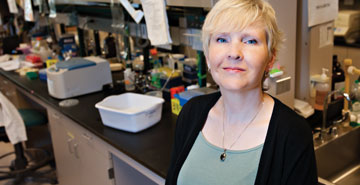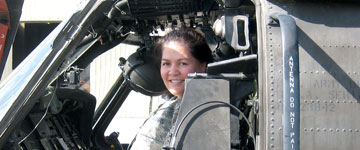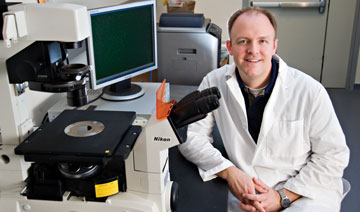Volume 29 · Number 1 · Fall 2011
The military goes to college
The kinds of UC Davis research funded by the Pentagon might surprise—and benefit—you.

Colleen Sweeney is studying the effects of stress on breast cancer. (Karin Higgins/UC Davis)
In her first-floor, corner laboratory on the UC Davis Health System campus in Sacramento, Colleen Sweeney is studying genetically modified mice to identify how stress might affect breast cancer. About 15 miles away in Davis, chemistry professor Matthew Augustine is adapting technology he developed to analyze valuable bottles of wine for use in detecting liquid explosives at airports. And physics professor Richard Scalettar spent the summer mentoring a team of West Sacramento high school students in computer modeling of superconductivity.
These scientists and their seemingly unrelated interests have something in common, as do a number of other UC Davis scholars pursuing a wide range of disciplines: Their work is supported by the U.S. Department of Defense. Increasingly, the Pentagon is funding projects and pursuits that are wholly unexpected for the federal bureaucracy that is home to the nation's armed forces. But as scientists like Sweeney, Augustine, Scalettar and others learn from their collaborations with the military, civilians as well as the Defense Department ultimately benefit.
"There's a particular focus on thinking that is outside the box, that's new and innovative," said Sweeney, the breast cancer researcher. "They're willing to take a leap of faith."
To be sure, the Defense Department continues to support research at UC Davis and elsewhere in more traditional areas—battlefield medicine, trauma surgery, communications and applied mathematics. In fact, UC Davis trauma surgeon Lynnette Scherer spent two weeks last fall in Afghanistan, where she worked as part of a surgical team of civilian and military surgeons treating and studying blast injuries at a military hospital near Kabul.
In all, the Department of Defense awarded almost $20 million for research at UC Davis in fiscal year 2009–10—the latest figures available—for 79 projects. That's a small slice of UC Davis' nearly $679 million in annual research funding and just a fraction of the funding from the National Institutes of Health (more than $250 million) and the National Science Foundation (more than $60 million). But faculty with defense funding say Pentagon grants go a long way, dollar for dollar, by supporting promising but untested ideas, sometimes with big results.
"The military spends money to solve specific problems," said David Dawson, a professor of vascular surgery and a lieutenant colonel in the U.S. Air Force Reserve who accompanied Scherer to Afghanistan. "But sometimes there are everyday spinoffs."
Colleen Sweeney's work using genetically modified mice to study the effects of stress on breast cancer might seem a long way from the military's mission. But in fact, the defense department is the second-largest funding source for cancer research in the U.S. after the National Institutes of Health.
In 1992, Congress appropriated $25 million for breast cancer research and gave the Pentagon the task of administering the program. From its inception, defense spokeswoman Gail Whitehead said in an email, the program has awarded grants to UC Davis.
According to its vision statement, the defense department's Congressionally Directed Medical Research Programs aim to "eradicate diseases and support the war fighter for the benefit of the American public."
In fiscal year 2010, the department gave almost $600 million in grants through the program, which now includes a wide range of diseases and conditions including prostate and ovarian cancer, traumatic brain injury, Gulf War syndrome, multiple sclerosis, osteoporosis and spinal cord injury.
Sweeney, an associate professor at the UC Davis Cancer Center, sits on a "study section," a scientific committee that reviews grant applications. Like an NIH study section, the Department of Defense panels subject grants to rigorous peer review, but its approach differs in many ways.
The program's grants are about half the size of an average NIH grant and, unlike NIH grants, are not renewable. But on the other hand, the defense medical programs reviewers are willing to take a shot on an innovative idea without the substantial preliminary research required by the NIH.
Sweeney and Brian Trainor, assistant professor of psychology, are using a genetically modified mouse that develops breast cancer in a predictable way when it is treated with a drug that switches on a specific gene. The gene, Erb 2, corresponds to a human gene linked to about a quarter of all breast cancers.
When the drug is taken away and Erb 2 is switched off, the tumors shrink.
It's no secret
Under long-standing policies, the University of California does not accept research proposals where the results cannot be published. That means that there is no "classified" research at UC Davis—classification being the system the U.S. government uses to keep sensitive information secret.
Trainor studies mice to better understand human conditions such as anxiety and depression. The researchers employ simple methods, such as temporarily placing the mouse in a confined space or alone in a cage, to induce stress, and measure corticosterone hormones that track stress levels. Then they look at how these stress levels relate to tumor growth and regression.
Now in its second year, the study is showing interesting results, though they are not yet ready for publication, Sweeney said.
If stress does have a significant effect on tumor biology, that could have an impact on clinical treatment for human cancer patients, Sweeney said. Currently, patients on chemotherapy receive drugs to prevent allergic reactions to their treatments. But those drugs are themselves similar to natural stress hormones, and could actually contribute to tumor growth. The mouse model can be used to test these questions and investigate alternative treatments, Sweeney said.
Air passengers one day may be able to carry their soaps, shampoo and bottled water onto the plane again, thanks to defense-funded efforts by chemistry professor Matthew Augustine to adapt scanning technology he originally developed to check wine bottles for spoilage without opening them.
In late 2010, the U.S. Department of Homeland Security's Science and Technology Directorate awarded a contract to a Denver-based defense firm to develop a magnetic resonance scanner that could be placed in airports and used to check bottles and cans for explosives without opening them. Augustine is building a prototype of the machine in his Chemistry Building lab with an initial allocation of $800,000.
The technology is similar to the magnetic resonance imaging machines used in medical scanning. It employs a pulse of radio waves and a strong magnetic field to extract a signal that shows the chemical structure of the sample.
The wine-scanning technology was patented by UC Davis in 2002 and licensed to Madison Avenue Management Inc., which set up a subsidiary company, Winescanner Inc., to commercialize it.
After a thwarted 2006 plot in which terrorists planned to carry liquid explosives on board at least 10 transatlantic airliners, Augustine started looking into whether magnetic resonance could be used to identify more than bad wine. "I'm a tinkerer. I like to build stuff," he said.
Early tests showed that his wine-analysis technique could distinguish gasoline or other dangerous liquids from toothpaste or other innocuous ones. But the challenge was to design a system suitable for use in airports. It needed to be relatively small, easy and quick to use, and capable of scanning containers in a wide range of sizes and shapes, from lipsticks to water bottles.
Arriving at such a design involved careful trade-offs between high-frequency radio waves, which give the best information about chemical structures but are blocked by metal, and lower-frequency waves that can pass through a soda can.
Other defense grants are being used on campus to surprising ends. Physics professor Richard Scalettar used Army Research Office funding to bring a group of students from River City High School in West Sacramento to UC Davis for summer research. The students learned to make computer models of materials for research in superconductivity and other areas.
And even weapons research has unexpected aims—not to kill. Neville Luhmann, professor of electrical engineering, is developing microwave-generating technology for use in an "Active Denial System"—a riot control device that causes pain without lasting damage. The work is funded by the Joint Non-Lethal Weapons Directorate of the Department of Defense.
The high-frequency microwave beam penetrates just far enough into the skin to reach nerve endings that transmit pain signals. The sensation is like touching an incandescent light bulb, Luhmann said—you instinctively run or jump away.
High-frequency microwave beams can also be used for research into nuclear fusion, high-speed communications, radar imaging, and possibly for detecting biological or chemical agents.
The Pentagon has previously demonstrated a truck-mounted "Active Denial System," developed by defense contractor Raytheon. But that system uses an expensive superconducting magnet that takes several hours to cool to a working temperature.
"It's a high power system, but impractical," Luhmann said. "We need better source technology."
In the UC Davis device, a sheet of electrons passes through a vacuum tube made of etched copper plates. The electrons are "bunched" by radio waves before being emitted from the device. Eventually, mass fabrication of the devices will take place with an industry partner. The devices could become standard on the U.S. military's next generation Ground Combat Vehicle, replacing Strykers and Bradley Fighting Vehicles.

Lynette Scherer is chief of trauma at the UC Davis Health System. (courtesy photo)
Scherer, chief of trauma and emergency surgery at the UC Davis Health System, was in Afghanistan last October with her team of civilian and military surgeons, operating on patients and learning from the brutal experience of war injuries. The trip was sponsored by U.S. Air Force Central Command.
Scherer's group included Dawson, the vascular surgery professor and Air Force Reserve officer; Ronald Maier of Harborview Medical Center in Seattle; Donald Trumkey, Oregon Health Sciences University; and U.S. Air Force Col. Warren Dorlac, Cincinnati. The surgeons spent two weeks in Afghanistan working at Bagram Air Base and also visiting Kandahar.
They operated on military patients arriving from forward operating bases, removing temporary fixes, cleaning wounds and stabilizing patients so they could be transported to Germany and the U.S. The surgeons also treated Afghan civilians
injured by land mines or in fighting.
"There were some very, very complicated wounds," Scherer recalled. Most of the injuries were due to explosions that result in wounds with extensive tissue damage, dirt and foreign material.
"It's really unusual for us [at the Medical Center] to see wounds with that degree of surrounding injury," Scherer said.
Civilian trauma surgeons learn from the military, Scherer said. For example, battlefield experience shows that whole blood is more effective in patients than blood components—a change that has been implemented at UC Davis and other civilian trauma units, she said.
"We've learned from these war wounds," Scherer said. "The way we resuscitate patients, the way we give blood has changed, and that's been driven by the conflict."
One outcome of the wars in Iraq and Afghanistan has been a surge of knowledge in emergency medicine and care for the critically ill, Dawson said.
Dawson served 10 years in the Air Force and rejoined the reserve last June after an eight-year break. He served as a "translator" between the military and civilian surgeons on the trip.
"It was interesting for me to accompany the civilian surgeons and see them look at how it's done," Dawson said. "It's rewarding that they were so impressed with the quality of care and the professionalism of those doing the job."
Other defense research
The Department of Defense annually funds about $20 million worth of research at UC Davis. Here are a few more examples . . .
Stateside, Dawson is working on teaching collaborations between UC Davis and the David Grant Medical Center at Travis Air Force Base in Fairfield. The two centers have a joint training program in general surgery, and Dawson and colleagues are developing a training program in vascular surgery. There are also teaching and research collaborations between both hospitals and the Veterans Administration system.
The collaborations mean doctors and surgeons can share expertise in areas such as endoscopy and colorectal surgery, Dawson said. There are also active joint clinical research programs, for example in "virtual care" (the use of robotics and telecommunications in medicine), and in artificial replacements for blood vessels.
The Department of Defense is a useful research partner because its approach complements other funding sources, Dawson said.
For example, the Defense Advanced Research Projects Agency, or DARPA, has in the past supported the development of small, portable ultrasound machines for use in the field. That led to point-of-care ultrasound machines now in use in civilian intensive care units.
In addition, the Pentagon has invested heavily in research in informatics (handling and interpreting very large amounts of data), imaging, telemedicine and hemorrhage control over the past decade, Dawson added.
The path from lab to clinic to battlefield is easy enough to see in Kent Leach's work. An associate professor in the Department of Biomedical Engineering, Leach was awarded two grants totaling $750,000 by the U.S. Army last year to work on using stem cells from fat tissue to speed bone healing.

Kent Leach's research may someday enable doctors to treat bone injuries with stem cells from fat tissue. (Karin Higgins/UC Davis)
The most common source of adult stem cells is bone marrow. But accessing bone marrow involves a painful operation, and the cells are relatively scarce so their numbers need to be expanded by growing them in the laboratory.
On the other hand, even the fittest soldier has fat deposits that can yield large numbers of adult stem cells, Leach said.
"We can get a lot of cells very quickly from fat," he said.
Once those cells have been taken out of the body and separated, the next step is to encourage them to move into the damaged tissue and turn themselves into bone-forming cells.
To do that, Leach's lab has developed different kinds of materials that can be injected or implanted into damaged bones, including a jello-like matrix similar to a blood clot and more solid, foamy materials.
Leach has seven grants to fund his research, including the two from the Army and two from the National Institutes of Health, as well as philanthropic funding from The Hartwell Foundation and the AO Foundation, a Swiss foundation that focuses on bone trauma.
Leach noted that the military sets specific milestones to be met for their grants. In the second year of funding, he is required to attend a research meeting where Pentagon officials will grill researchers on their progress.
"They are very focused on generating technology that helps the military," Leach said.
Generating breakthrough technology is also the aim of Department of Defense grants to researchers in the College of Engineering. The Pentagon is the largest source of funding for Ben Yoo, professor of electrical and computer engineering, whose laboratory works on optical communications and networking.
"I'm very fortunate to have been funded continuously by DARPA for 18 years in a row," Yoo said.
Yoo's projects include using light pulses for supercomputers and data centers to transmit data at much faster speed, broader bandwidth and higher power efficiency than their current electronic pulses allow. He recently concluded a DARPA-funded collaboration with the Massachusetts Institute of Technology on devices to generate light pulses containing 10 trillion bits of information per second, and is working with Venkatesh Akella, professor of electrical and computer engineering at UC Davis, on a Department of Defense-funded project on supercomputers with optical interconnections.
Yoo's project has enabled him to design and demonstrate an optical chip that can generate and receive optical data at many trillions of bits per second, and his project with Akella allowed them to design optical switches that interconnect huge data centers and supercomputers with thousands of ports, each running a trillion bits per second—essentially computers that run on light.
High-speed, high-efficiency communications are obviously of interest to the military, but they also clearly have a high potential for civilian spin-offs in computer networks and the Internet.
Yoo said that just as the defense medical research program funding complements the NIH and other funding sources for biomedical researchers like Leach and Sweeney, DARPA's funding style complements that of the National Science Foundation, the other federal agency that funds engineering research.
While the NSF tends to spread its budget more widely, supporting many academic scientists and engineers, DARPA tends to fund team efforts of well-established researchers across industry and universities based on more goal-oriented projects.
"If I lead a team to apply for a grant, I may be competing against Lockheed and General Dynamics as well as Stanford," he said. At the same time, the agency recognizes that universities do things differently from industry—for example, by involving students in research—so projects can be a lot more labor-intensive than would be possible with a company.
"These projects teach our students to be team-oriented and carry out large-scale research with industry partners," Yoo said.
A NSF grant provides a chunk of funds every year, while Yoo's DARPA grants require him to meet quarterly milestones.
While the Department of Defense provides a relatively small slice of UC Davis's total research funding, the Pentagon's goal-oriented approach, willingness to back bright ideas that may or may not pay off, and emphasis—especially through DARPA—on "team science" provide a valuable addition to the funding mix. And DARPA, which for the past decade had turned to private industry contractors, is looking again to university researchers for "blue-sky" ideas, according to an article earlier this year in Prism, the magazine of the American Society for Engineering Education.
"A relationship with the Department of Defense is a useful thing for a university," Dawson said. "For a long time there was awareness, now there is broader awareness, and we want to continue to broaden and deepen the relationship."
Andy Fell writes about science and engineering for UC Davis News Service.
